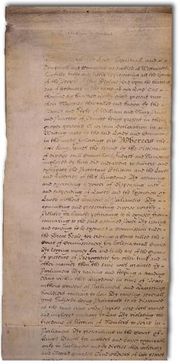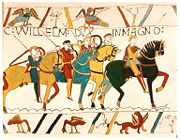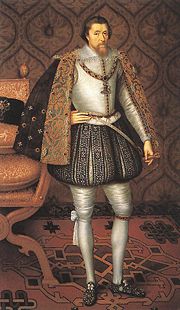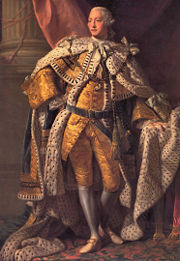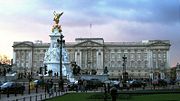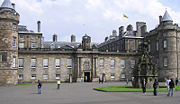Monarchy of the United Kingdom
2008/9 Schools Wikipedia Selection. Related subjects: UK Politics & government
| Queen of the United Kingdom of Great Britain and Northern Ireland | |
|---|---|
| Monarchy | |
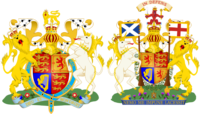 Royal Coat of Arms of the United Kingdom of Great Britain and Northern Ireland |
|
 |
|
| Incumbent: Elizabeth II |
|
| Style: | Her Majesty |
| Heir apparent: | Charles, Prince of Wales |
| First monarch: | open to interpretation |
| Formation: | 1 May 1707 |
The monarchy of the United Kingdom (commonly referred to as the British monarchy) is a system of government in which a hereditary monarch is the sovereign of the United Kingdom and its overseas territories; the terms British monarch and British monarchy may also mean different things in different contexts beyond the United Kingdom.
The present monarch is Queen Elizabeth II, who has reigned since 6 February 1952. The Queen, the current heir apparent – Elizabeth's eldest son, Charles, Prince of Wales (known as Duke of Rothesay in Scotland) – the Queen's consort, Prince Philip, Duke of Edinburgh, and the remainder of the Royal Family, undertake various public duties in accordance with their positions; since the Magna Carta, and through the English Civil War and the Restoration, the political powers of the monarch have gradually decreased. Today, the monarch's role is constitutional, and limited to non-partisan functions such as bestowing honours. Despite this, the ultimate executive authority over the government of the United Kingdom is still, by and through, the monarch's royal prerogative. Such powers include the dissolution of parliament, and the making of the rules for the government and regulation of the civil service and the armed forces. But these powers are only used according to the policies and procedures set down by laws enacted in Parliament and; where the laws be silent, within the constraints of convention and precedent. The monarch has a variety of official and private royal residences, and the Crown Estate, with assets worth over £7 billion, is one of the largest property owners in the world.
Following the declaration of Indian independence, George VI and his successor, Elizabeth II, adopted the title Head of the Commonwealth. Besides reigning in the UK, Queen Elizabeth II also serves as head of state for 15 other Commonwealth countries, putting the United Kingdom in a personal union relationship with those other countries. This developed from the former colonial relationship of these countries to Britain, but these countries are now independent and the monarchy of each is legally distinct.
Context
Monarchical lineage
The British monarchy can trace its institutional lineage back to the kings of the Angles and the early Scottish kings. By the year 1000, the petty kingdoms of early medieval Britain had resolved into the kingdoms of England and Scotland. The last Anglo-Saxon monarch (Harold II) was defeated and killed in the Norman invasion of 1066 and the English monarchy passed to the Norman conquerors. From 1603, when the Scottish king James VI inherited the English throne as James I, both kingdoms were ruled by a single monarch. From 1649 to 1660, the tradition of monarchy was broken by the republican Commonwealth of England that followed the War of the Three Kingdoms. In 1707 the kingdoms of England and Scotland were merged to create the Kingdom of Great Britain and, in 1801, the Kingdom of Ireland became joined to create the United Kingdom of Great Britain and Ireland. Most of Ireland seceded from the Union in 1922 as the Irish Free State, but in law the Monarch remained sovereign there until 1949.
Terms
The terms British monarch and British monarchy can refer, respectively, to the monarch of the United Kingdom and the royal institution he or she heads in that country. However, despite the splitting, in 1931, of the unitary British monarchy throughout its empire into legally distinct crowns for each of the Commonwealth realms, the two terms are still frequently applied in non-British legal fields to the extranational person and the institution shared amongst all 16 of those countries. Similarly, for reasons historical, political, and of convenience, the terms are also commonly used beyond the UK, including in the non-UK Commonwealth realms, to refer to the monarch and crown in non-British contexts, at variance with the official national titles and terms for each of those jurisdictions.
Modern status
International and domestic aspects
Fifteen states within the 53-member Commonwealth of Nations; former territories of the British Empire are in a personal union with the United Kingdom. These 16 countries are known as the Commonwealth realms, each of which is sovereign and independent of the others.
Development of shared monarchy
Prior to 1926 the British Crown reigned over the British Empire collectively, the Dominions and Crown colonies being subordinate to the United Kingdom. The Balfour Declaration of 1926 gave the Dominions the right to be considered equal to Britain, effectively creating a system whereby a single monarch operated independently in each Commonwealth realm. The monarchy thus ceased to be an exclusively British institution, although it is often still referred to as "British" for legal and historical reasons and for convenience.
The first indication of this shift in constitutional law was the Royal and Parliamentary Titles Act, 1927, and the concept was solidified by the Statute of Westminster, 1931. According to the latter, which has been likened to a treaty amongst the Commonwealth realms, the personal union relationship is such that any change to the laws governing succession to the throne in any realm requires the unanimous consent of all the realms. Thus, neither the United Kingdom nor any other realm can unilaterally change the rules of succession, unless they explicitly remove themselves from the shared monarch relationship.
On all matters pertaining to the United Kingdom of Great Britain and Northern Ireland the monarch is advised solely by her British Ministers of the Crown.
Succession
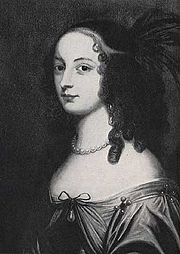
Succession is governed by several enactments, the most important being the Bill of Rights 1689 and Act of Settlement 1701. The rules of succession may be changed by an Act of Parliament.
Succession is according to the rules of male-preference cognatic primogeniture, under which sons inherit before daughters, and elder children inherit before younger ones of the same sex. The Act of Settlement, however, restricts the succession to the natural (i.e. not adopted) legitimate descendants of Sophia of Hanover (1630–1714), a granddaughter of James I.
The Bill of Rights and Act of Settlement include religious restrictions, which were imposed because of the English and Scots' distrust of Roman Catholicism during the late 17th century. Most importantly, only individuals who are Protestants at the time of the succession may inherit the Crown. A person who has at any time professed Roman Catholicism, or has ever married a Roman Catholic, is also prohibited from succeeding. An individual who is thus disabled from inheriting the Crown is deemed "naturally dead" for succession purposes, and the disqualification does not extend to the individual's descendants. In recent years there have been efforts to remove the religious restrictions (especially the specific rules relating to Roman Catholicism), but the provisions remain in effect.
Upon a "demise in the Crown" (the death of a sovereign) his or her heir immediately and automatically succeeds, without any need for confirmation or further ceremony (hence the phrase " The King is dead. Long live the King!"). Nevertheless, it is customary for the accession of the sovereign to be publicly proclaimed by an Accession Council that meets at St. James's Palace. After an appropriate period of mourning has passed, the monarch is crowned in Westminster Abbey, normally by the Archbishop of Canterbury. A coronation is not necessary for a sovereign to reign; for example, Edward VIII was never crowned because he abdicated before the ceremony.
After an individual ascends the throne, he or she reigns until death. There is no provision for a monarch to abdicate; the only monarch to do so, Edward VIII (1936), was authorised by a special Act of Parliament, His Majesty's Declaration of Abdication Act 1936. Numerous reigns have ended due to irregular or extralegal procedures; several monarchs have been killed, deposed, or forced to abdicate, chiefly during the 14th and 15th centuries. The last monarch involuntarily removed from power was James VII and II, who fled the realm in 1688 during the Glorious Revolution; the English Parliament deemed him to have abdicated, while the Scottish Parliament declared him to have forfeited the throne.
The current Government has announced that it intends to bring forward legislation to change the law of succession to give equal rights to males and females, and to remove the exclusion of those marrying Roman Catholics.
Regency
Under the Regency Act, 1937, and Regency Act 1953, the powers of a monarch who has not reached the age of 18 or who is physically or mentally incapacitated must be exercised by a regent. A physical or mental incapacity must be certified by at least three of the following persons: the sovereign's spouse, the Lord Chancellor, the Speaker of the House of Commons, the Lord Chief Justice of England and Wales, and the Master of the Rolls. The declaration of three of the same people is necessary to terminate the regency and to allow the monarch to resume power.
When a regency is necessary, the next qualified individual in the line of succession automatically becomes regent. The regent must be at least 21-years old (18 years for the heir apparent or heir presumptive), be a British subject and be domiciled in the United Kingdom. Special provisions were made for Queen Elizabeth II by the Regency Act, 1953, which states that the Duke of Edinburgh (the Queen's husband) may act as regent in certain circumstances. The only individual to have acted as regent was the future George IV, who took over while his father, George III, was considered insane (1811–1820).
During a temporary physical infirmity or an absence from the kingdom, the sovereign may temporarily delegate his or her functions to Counsellors of State, the monarch's spouse and the first four qualified people in the line of succession. The qualifications for Counsellors of State are the same as those for regents. The present Counsellors of State are: The Duke of Edinburgh, The Prince of Wales, Prince William of Wales, Prince Henry of Wales and The Duke of York.
Finances
Parliament meets much of the sovereign's official expenditure from public funds. The Civil List covers most expenses, including those for staffing, state visits, public engagements, and official entertainment. The size of the Civil List is fixed by parliament every 10 years; any money saved may be carried forward to the next 10-year period. The Civil List expenditure in 2003 was approximately £9.9 million. In addition, the sovereign receives an annual Property Services Grant-in-Aid (£15.3 million for FY 2003–2004) to pay for the upkeep of the royal residences, and an annual Royal Travel Grant-in-Aid (£5.9 million for FY 2003–2004). The Civil List and the Grants-in-Aid are paid from public funds.
Until 1760 the monarch met all official expenses from hereditary revenues, including the profits of the Crown Estate. King George III agreed to surrender the hereditary revenues of the Crown in return for the Civil List, and this arrangement persists. In modern times, the profits surrendered from the Crown Estate have by far exceeded the Civil List and Grants-in-Aid provided to the monarch. For example, the Crown Estate produced over £170 million for the Treasury in the financial year 2003–2004, whereas parliamentary funding for the monarch was less than £40 million during the same period. The monarch continues to own the Crown Estate, but cannot sell it; the estate passes from one sovereign to the next.
The sovereign also owns the Duchy of Lancaster as private inherited property. Like the Crown Estate the Duchy is held in trust, and cannot be sold. The revenues of the Duchy of Lancaster need not be surrendered to the Treasury; they form part of the Privy Purse, and are used for expenses not borne by the Civil List. The Duchy of Cornwall is a similar estate held in trust to meet the expenses of the monarch's eldest son.
The sovereign is subject to indirect taxes such as the value added tax (VAT), but is exempt from income tax and capital gains tax. Since 1993 the Queen has paid taxes on personal income. As the Civil List and Grants-in-Aid are used solely for official expenditure, they are not taken into account when calculating taxes.
Assets
The Crown Estate (the royal property portfolio) is one of the largest property owners in the United Kingdom, with a portfolio worth over £7 billion (US$14.35 billion) in 2007.
In 1999 Eurobusiness magazine listed the Windsors' assets as:
- Cash and investments: £520 million
- Art collection: £1 billion
- Jewellery: £130 million
The Royal Collection is not the personal property of the Windsors but is administered by the Royal Collection Trust, a registered charity.
Constitutional role
In the uncodified Constitution of the United Kingdom political power is ultimately exercised by the Parliament of the United Kingdom, of which the Sovereign is a non-partisan component. Political power is exercised by the House of Lords and the House of Commons, and by the Prime Minister and the Cabinet. The monarchy is a constitutional one; the Sovereign's role is limited to non-partisan functions such as granting honours. This role has been recognised since the 19th century; in The English Constitution (1867) Walter Bagehot identified the monarchy as the "dignified part" rather than the "efficient part" of government. The sovereign is the Supreme Governor of the established Church of England, although spiritual leadership of the Church is the responsibility of the Archbishop of Canterbury.
Whenever necessary, the Sovereign is responsible for appointing a new Prime Minister (with an option to appoint none at all, which, politically, is extremely unlikely); the appointment is formalised at a ceremony known as Kissing Hands. In accordance with unwritten constitutional conventions, the Sovereign must appoint the individual most likely to maintain the support of the House of Commons, usually the leader of the party that has a majority in that House. If no party has a majority (an unusual occurrence, given the United Kingdom's First Past the Post electoral system), two or more groups may form a coalition, whose agreed leader is then appointed Prime Minister. In a " hung parliament", in which no party or coalition holds a majority, the monarch has an increased degree of latitude in his or her choice of Prime Minister, but the individual most likely to command the support of the Commons, usually the leader of the largest party, must be appointed. For example, following the February 1974 general election, after failed negotiations between Edward Heath and Liberal leader Jeremy Thorpe, Heath resigned and Harold Wilson was appointed Prime Minister although his Labour Party did not have a majority. According to Lascelles Principles, if a minority government tried to dissolve Parliament to call an election early to strengthen its position, the monarch could refuse and allow opposition parties to form a coalition government. Harold Wilson's February 1974 minority government called an early election in October 1974, which gave it a small majority.
The Sovereign appoints and dismisses Cabinet and other ministers, on the Prime Minister's advice — in practice, the Prime Minister, and not the Sovereign, exercises control over the composition of the Cabinet. The monarch may in theory unilaterally dismiss a Prime Minister, but convention and precedent tightly restrict such an action. The last monarch to remove a Prime Minister was William IV, who dismissed Lord Melbourne in 1834. In practice, a Prime Minister's term comes to an end only with death, resignation or electoral defeat.
The monarch holds a weekly audience with the Prime Minister and regular audiences with other members of the Cabinet. The monarch may express his or her views, but, as a constitutional ruler, must ultimately accept the Prime Minister's and Cabinet's decisions (subject to the Crown's authority to appoint a new Prime Minister and ministers, itself limited by convention). Walter Bagehot, the 19th-century constitutional writer, summarised this concept: "the Sovereign has, under a constitutional monarchy ... three rights — the right to be consulted, the right to encourage, the right to warn."
Any member of the Cabinet who wishes to be absent from the United Kingdom for any reason, except for official visits to European Union or NATO member countries, must seek both the Prime Minister's and the Queen's approval to leave the country, and must at the same time inform "Her Majesty ... of the arrangements made for the administration of the Minister's Department during his or her absence".
The monarch has a similar relationship with the devolved governments of Scotland, Wales, and Northern Ireland. The Sovereign appoints the First Minister of Scotland on the nomination of the Scottish Parliament. The First Minister of Wales is nominated by the National Assembly for Wales and appointed upon approval by the Sovereign. In Scottish matters, the Sovereign acts on the advice of the Scottish Government. However, as devolution is more limited in Wales, the Sovereign acts on the advice of the Prime Minister and Cabinet of the United Kingdom in Welsh matters. The Sovereign can strike out any Northern Ireland law, although voted by the Assembly, if deemed unconstitutional by the Secretary of State for Northern Ireland.
The Sovereign is the Head of State in the United Kingdom. Oaths of allegiance are made to the Queen, not to Parliament or to the nation. Moreover, God Save the Queen (or God Save the King) is the British national anthem. The monarch's visage appears on postage stamps, on coins, and on banknotes issued by the Bank of England. Banknotes issued by other British banks, such as the Bank of Scotland and the Ulster Bank, do not depict the Sovereign.
Royal Prerogative
The executive authority of the government is theoretically and nominally vested in the Sovereign, collectively known as the Royal Prerogative. The Royal Prerogative includes many powers, such as the powers to dissolve Parliament, regulate the civil service, issue passports, make treaties or send ambassadors, and duties such as the duties to defend the realm and to maintain the Queen's peace. As the monarchy is constitutional, the monarch acts within the constraints of convention and precedent, exercising the Royal Prerogative on the advice of ministers. Parliamentary approval is not required for the exercise of the Royal Prerogative; the Consent of the Crown must be obtained before either House may even debate a bill affecting the Sovereign's prerogatives or interests. Although the Royal Prerogative is extensive, it is not unlimited. For example, the monarch does not have the prerogative to impose and collect new taxes; such an action requires the authorisation of an Act of Parliament.
According to a parliamentary report, "The Crown cannot invent new prerogative powers", many Crown prerogatives have been permanently transferred to Parliament, and more may be in the future.
The Sovereign is one of the three components of Parliament; the others are the House of Lords and the House of Commons. It is the prerogative of the monarch to summon, prorogue and dissolve Parliament. Each parliamentary session begins with the monarch's summons. The new parliamentary session is marked by the State Opening of Parliament, during which the Sovereign reads the Speech from the Throne in the Chamber of the House of Lords, outlining the Government's legislative agenda. Prorogation usually occurs about one year after a session begins, and formally concludes the session. Dissolution ends a parliamentary term (which lasts a maximum of five years), and is followed by general elections for all seats in the House of Commons. These powers, however, are always exercised on the Prime Minister's advice. The timing of a dissolution is affected by a variety of factors; the Prime Minister normally chooses the most politically opportune moment for his or her party. Per the Lascelles Principles, the Sovereign may theoretically refuse a dissolution, but the circumstances under which such an action would be warranted are unclear. No parliamentary term may last more than five years; at the end of this period, a dissolution is automatic under the Parliament Act 1911.
All laws are enacted in the monarch's name. The words "BE IT ENACTED by the Queen's [King's] most Excellent Majesty, by and with the advice and consent of the Lords Spiritual and Temporal, and Commons, in this present Parliament assembled, and by the authority of the same, as follows", known as the enacting formula, form a part of each Act of Parliament. Before a bill can become law, the Royal Assent (the monarch's approval) is required. The Sovereign may, in theory, either "grant" the Royal Assent (make the bill law) or "withhold" the Royal Assent (veto the bill). In practice the Royal Assent is almost always granted; the last monarch to withhold Assent was Anne, who rejected a Scots militia bill in 1708. There is no provision for Parliamentary override of a veto (lack of Royal Assent) comparable to a U.S. Congressional (legislative) override of a President's veto.
The Royal Prerogative with respect to domestic affairs is extensive. The Crown is responsible for the appointment and dismissal of ministers, Privy Counsellors, members of various executive agencies and other officials. Effectively, however, the appointees are chosen by the Prime Minister, or, for less important offices, by other ministers. In addition, the monarch is the head or commander in chief of the Armed Forces (the Royal Navy, the British Army, and the Royal Air Force). It is the Sovereign's prerogative to declare war, make peace and direct the actions of the military, although the Prime Minister holds de facto decision-making power over the British armed forces. Many of the Sovereign's prerogative powers are exercised through the Privy Council.
The Royal Prerogative extends to foreign affairs. The Sovereign may negotiate and ratify treaties, alliances, and international agreements; no parliamentary approval is required. A treaty cannot alter the domestic laws of the United Kingdom; an Act of Parliament is necessary in such cases. The Sovereign accredits British High Commissioners and ambassadors, and receives diplomats from foreign states. British passports are issued in the monarch's name.
The Sovereign is deemed the "fount of justice", and is responsible for rendering justice for all subjects. The Sovereign does not personally rule in judicial cases, but judicial functions are performed in his or her name. For instance, prosecutions are brought on the monarch's behalf, and courts derive their authority from the Crown. The common law holds that the Sovereign "can do no wrong"; the monarch cannot be prosecuted for criminal offences. The Crown Proceedings Act 1947 allows civil lawsuits against the Crown in its public capacity (that is, lawsuits against the government), but not lawsuits against the monarch personally. The Sovereign exercises the "prerogative of mercy", and may pardon offences against the Crown before, during, or after a trial.
The monarch is the " fount of honour", the source of all honours and dignities in the United Kingdom. The Crown creates all peerages, appoints members of the orders of chivalry, grants knighthoods and awards other honours. In practice, peerages and most other honours are granted on the advice of the Prime Minister. Some honours are within the personal gift of the Sovereign, and are not granted on ministerial advice — the monarch alone appoints members of the Order of the Garter, the Order of the Thistle, the Royal Victorian Order and the Order of Merit.
The Sovereign is the Supreme Governor of the Church of England, the officially established church in England, with the power to appoint archbishops and bishops. The Prime Minister, however, chooses the appointee from a list of nominees prepared by the Crown Nominations Commission. The Crown's role in the Church of England is titular; the most senior clergyman, the Archbishop of Canterbury, is the spiritual leader of the Church and of the worldwide Anglican Communion. The monarch is only an ordinary member, of the Church of Scotland, but he or she holds the power to appoint the Lord High Commissioner to the Church's General Assembly. The Sovereign plays no formal role in the Church in Wales and the Church of Ireland, neither of which is an established church.
The Great Seal of the Realm authenticates important official documents, including letters patent, proclamations and writs of election. It is in the custody of the Lord Chancellor. For matters relating exclusively to Scotland or Northern Ireland, the Great Seal of Scotland or the Great Seal of Northern Ireland are used.
The monarch has the power to claim any sturgeons, porpoises, whales or dolphins that are either washed ashore or captured within 3 miles (4.8 km) of the British coast. This power comes from a statute from King Edward II in 1324. One who purchases these fish, abiding by the statute, has the honour of being loyal to the crown.
History
English monarchy
Following the Viking raids and settlement of the ninth century, the kingdom of Wessex emerged as the dominant English kingdom. Alfred the Great secured Wessex and achieved dominance over western Mercia, and assumed the title "King of the English". His grandson Athelstan was the first king to rule over a unitary kingdom roughly corresponding to the present borders of England, but even by the reign of Edgar the Peaceful England was not beyond fracturing into its constituent parts. The 11th century saw England become more stable, despite a number of wars with the Danes, which resulted in a Danish monarchy for some years. When William, Duke of Normandy conquered England in 1066 he became monarch of a kingdom with probably the strongest royal authority in Europe. The Norman Conquest was crucial in British history, in terms of both political and social change. The new monarch continued the centralization of power begun in the Anglo-Saxon period, while the Feudal System continued to develop.
William I was succeeded by two of his sons: William II, then Henry I. Henry made a controversial decision to name his daughter Matilda (his only surviving child) as his heir. Following Henry's death in 1135, one of William I's grandsons, Stephen, laid claim to the Throne, and took power with the support of most of the barons. Stephen's weak rule allowed Matilda to challenge his reign; as a result England descended into a period of disorder known as The Anarchy. Stephen maintained a precarious hold on power for the rest of his life, but he agreed to a compromise under which he would be succeeded by Matilda's son Henry, who accordingly became the first monarch of the Angevin, or Plantagenet, dynasty as Henry II in 1154.
The reigns of most of the Angevin monarchs were marred by civil strife and conflicts between the monarch and the nobility. Henry II faced rebellions from his own sons, the future monarchs Richard I and John. Nevertheless, Henry managed to expand his kingdom, most notably with the conquest of Ireland, which had previously consisted of a multitude of rival kingdoms. Henry granted Ireland to his younger son John, who ruled as "Lord of Ireland".
Upon Henry's death, his elder son Richard succeeded to the throne; he was absent from England for most of his reign, as he was fighting the Crusades in the Near East. When he died, John succeeded him, thereby uniting England and Ireland under a single monarch. John's reign was marked by conflict with the barons, particularly over the limits of royal power. In 1215. the barons coerced the king into issuing the Magna Carta (Latin for "Great Charter") to guarantee the rights and liberties of the nobility. Soon afterwards John repealed the charter, plunging England into a civil war known as the First Barons' War. The war came to an abrupt end after John died in 1216, leaving the Crown to his nine-year-old son Henry III. The barons, led by Simon de Montfort, 6th Earl of Leicester, rebelled again later in Henry's reign, beginning the Second Barons' War. The war ended in a clear royalist victory, and in the execution of many rebels, but not before the king had agreed to summon a parliament in 1265.
The next monarch, Edward I, was far more successful in maintaining royal power, and was responsible for the conquest of Wales and the attempt to establish English domination in Scotland. However, gains in Scotland were reversed during the reign of his successor, Edward II, who was also occupied with a disastrous conflict with the nobility. Edward II was, in 1311, forced to relinquish many of his powers to a committee of baronial "ordainers"; however, military victories helped him regain control in 1322. Nevertheless, in 1327, Edward was deposed (and later murdered) by his wife Isabella and by his son, who became Edward III. The new monarch soon also claimed the French Crown, setting off the Hundred Years' War between England and France. Edward III's campaigns were largely successful, and culminated in the conquest of much French territory. Edward's reign was also marked by the further development of Parliament, which came to be divided into two Houses for the first time. In 1377, Edward III died, leaving the Crown to his 10-year-old grandson Richard II. The new monarch, like many of his predecessors, conflicted with the nobles, especially by attempting to concentrate power in his own hands. In 1399, while he was away in Ireland, his cousin Henry Bolingbroke seized power. Richard was then forced to abdicate and was murdered.
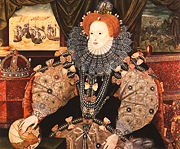
Henry IV was the grandson of Edward III and the son of John of Gaunt, Duke of Lancaster; hence, his dynasty was known as the House of Lancaster. For most of his reign, Henry IV was forced to fight off plots and rebellions; his success was partly due to the military skill of his son, the future Henry V. Henry V's own reign, which began in 1413, was largely free from domestic strife, leaving the king free to pursue the Hundred Years' War in France. Henry V was victorious in his conquest; however, his sudden death in 1422 left his infant son Henry VI on the Throne, and gave the French an opportunity to overthrow English rule. The unpopularity of Henry's regents, and afterwards, Henry's own ineffectual leadership, led to the weakening of the House of Lancaster. The Lancastrians faced a challenge from the House of York, so called because its head, a descendant of Edward III, was Richard, Duke of York. Although the Duke of York died in battle in 1460, his eldest son Edward led the Yorkists to victory in 1461. The Wars of the Roses, nevertheless, continued intermittently during the reigns of the Yorkists Edward IV, Edward V, and Richard III. Ultimately, the conflict culminated in success for the Lancastrian branch, led by Henry Tudor (Henry VII), in 1485, when Richard III was killed in the Battle of Bosworth Field.
The end of the Wars of the Roses formed a major turning point in the history of the monarchy. Much of the nobility was either decimated on the battlefield or executed for participation in the war, and many aristocratic estates were lost to the Crown. Moreover, feudalism was dying, and the feudal armies controlled by the barons became obsolete. Hence, the Tudor monarchs easily re-established absolute supremacy in the realm, and the conflicts with the nobility that had plagued previous monarchs came to an end. The power of the Crown reached its zenith during the reign of the second Tudor king, Henry VIII. Henry VIII's reign was one of great political change; England was transformed from a weak kingdom into one of the powers of Europe. Religious upheaval also occurred, as disputes with the Pope led the monarch to break away from the Roman Catholic Church and to establish the Church of England (the Anglican Church). Another important result of Henry VIII's reign was the annexation of Wales (which had been conquered centuries earlier, but had remained a separate dominion) to England under the Laws in Wales Acts 1535–1542.
Henry VIII's son and successor, the young Edward VI, continued with further religious reforms. Edward VI died in 1553, precipitating a succession crisis. He was wary of allowing his Catholic elder half-sister Mary to succeed to the Throne, and therefore drew up a will designating Lady Jane Grey as his heiress, even though no woman had ever reigned over England. Jane's reign however lasted only nine days; with tremendous popular support, Mary deposed her, revoked her proclamation as Queen, and declared herself the lawful Sovereign. Mary I attempted to return England to Roman Catholicism, in the process burning numerous Protestants at the stake as heretics. Mary I died in 1558, and was succeeded by her half-sister Elizabeth I, who returned England to Protestantism.
Scottish monarchy
In Scotland, as in England, monarchies emerged after the withdrawal of Rome in the early fifth century. The three groups that lived in Scotland at this time were the Picts (who inhabited the kingdom of Pictavia), the Britons (who lived in several kingdoms in southern Scotland, including the Kingdom of Strathclyde), and the Gaels, or Scotti (who would later give their name to Scotland), of the Irish province of Dál Riata. Kenneth MacAlpin is traditionally viewed as the founder of united Scotland (or kingdom of Alba). The expansion of Scottish dominions continued over the next two centuries, as other territories such as Strathclyde were conquered.
Early Scottish monarchs did not inherit the Crown directly; instead the custom of alternating segments was followed, as in Ireland and previously among the Picts. The monarchy alternated between two, sometimes three, branches of the House of Alpin. As a result, however, the rival dynastic lines clashed, often violently. The problems relating to succession were especially illustrated by the period from 942 to 1005, during which seven consecutive monarchs were either murdered or killed in battle. The rotation of the monarchy between different lines was abandoned after Malcolm II of Scotland ascended the throne in 1005 having killed many rivals. Thus, when Duncan I of Scotland succeeded Malcolm II in 1034, he did so with no recorded opposition.
In 1040, Duncan suffered defeat in battle at the hands of Macbeth, the subject of William Shakespeare's play The Tragedy of Macbeth. Later, in 1057, Donnchad's son Malcolm III of Scotland avenged his father's death by defeating and killing Macbeth. The following year, after the murder of Macbeth's stepson Lulach on 17 March 1058, Malcolm ascended the throne as Malcolm III, becoming the first monarch of the House of Dunkeld.
From 1107 Scotland was briefly partitioned under the will of Edgar, who divided his dominions between his eldest surviving brother Alexander I (who ruled northern Scotland as a king) and his younger brother David (who ruled southern Scotland as an earl). After Alexander's death in 1124, David inherited his dominions, and Scotland became unified once more. David was succeeded by the ineffective Malcolm IV, and then by William the Lion, the longest-reigning King of Scots before the Union of the Crowns. William participated in a rebellion against King Henry II of England; however, the rebellion failed, and William was captured by the English. In exchange for his release, William was forced to acknowledge Henry as his feudal overlord. The English King Richard I agreed to terminate the arrangement in 1189, in return for a large sum of money needed for the Crusades. William died in 1214, and was succeeded by his son Alexander II. Alexander II, as well as his successor Alexander III, attempted to take over the Western Isles, which were still under the overlordship of Norway. During the reign of Alexander III, Norway launched an unsuccessful invasion of Scotland; the ensuing Treaty of Perth recognised Scottish control of the Western Isles and other disputed areas.
Alexander III's death in 1286 brought his three-year-old Norwegian granddaughter Margaret to the throne. On her way to Scotland in 1290, however, Margaret died at sea, precipitating a major succession crisis, during which there were 13 rival claimants. Several Scottish leaders appealed to King Edward I of England to settle the dispute. A court was set up with the Balliol and Bruce "factions" each nominating "assessors". Contrary to popular opinion, Edward did not choose John Balliol to be king. Balliol won the overwhelming support of the majority of assessors. However, Edward proceeded to treat Balliol as a vassal, and tried to exert considerable influence over Scottish affairs. In 1295, when Balliol renounced his allegiance to England, Edward I invaded and conquered Scotland. During the first ten years of the ensuing Wars of Scottish Independence, Scotland had no monarch present; however, it was informally led by William Wallace. After Wallace's execution in 1305, Robert the Bruce took over and declared himself king. Robert's efforts culminated in success, and Scottish independence was acknowledged in 1328. However, only one year later, Robert died, and the English again invaded under the pretext of restoring John Balliol's rightful heir, Edward Balliol, to the throne. Nonetheless, during further military campaigns, Scotland once again won its independence under Robert the Bruce's son David II.
In 1371, David II was succeeded by Robert II, the first Scottish monarch from the House of Stewart (later Stuart). The reigns of both Robert II and his successor, Robert III, were marked by a general decline in royal power. When Robert III died in 1406, regents had to rule the country; the monarch, Robert III's son James I, had been taken captive by the English. Having paid a large ransom, James returned to Scotland in 1424; in order to restore his authority, he used ruthless measures, including the execution of several of his enemies. James II continued his father's policies by subduing influential noblemen. At the same time, however, the Estates of Scotland (the Scottish Parliament) became increasingly powerful, often openly defying the King. Parliamentary power reached its zenith during the reign of the ineffective King James III. As a result, James IV and his successors tended to avoid calling parliamentary sessions, thereby checking the power of the Estates.
In 1513, James IV launched an invasion of England, attempting to take advantage of the absence of the English King Henry VIII. His forces met with disaster at Flodden Field; the King, many senior noblemen, and over 10,000 soldiers were killed. As James IV's son and successor, James V, was an infant, the government was taken over by regents. After he reached adulthood, James ruled successfully until another disastrous war with the English in 1542. James's death in the same year left the Crown in the hands of his six-day-old daughter, Mary; once again, a regency was established. Mary, a Roman Catholic, reigned during a period of great religious upheaval in Scotland. Due to the efforts of reformers such as John Knox, a Protestant ascendancy was established. Mary caused considerable alarm by marrying a fellow Catholic, Lord Darnley, in 1565. After Lord Darnley's assassination in 1567, Mary contracted an even more unpopular marriage with the Earl of Bothwell, who was widely suspected of Darnley's murder. The nobility rebelled against the Queen, forcing her to abdicate and to flee to England (where she was imprisoned and later executed by Elizabeth I). The Crown went to her infant son James VI, who was brought up as a Protestant. James VI would later become King of England upon the death of Queen Elizabeth I.
Personal union and republican phase
Elizabeth's death in 1603 brought about the end of the rule of the House of Tudor in England. She had no children, and was succeeded by the Scottish monarch James VI, whose maternal great-grandmother was Henry VIII's older sister. James VI ruled in England as James I after what was known as the " Union of the Crowns". Although England and Scotland were in personal union under one monarch — James I became the first monarch to style himself "King of Great Britain", in 1604 — they remained separate kingdoms. James belonged to the House of Stuart, a royal house whose monarchs experienced frequent conflicts with the English Parliament. The disputes frequently related to the issue of royal and parliamentary powers, especially the power to impose taxes. The conflict was especially pronounced during the reign of James I's successor Charles I, who provoked opposition by ruling without Parliament from 1629 to 1640 (the " Eleven Years' Tyranny"), unilaterally levying taxes, and adopting controversial religious policies (many of which were offensive to the Scottish Presbyterians and the English Puritans). In about 1642, the conflict between King and Parliament reached its climax as the English Civil War began. The war culminated in the execution of the king, the overthrow of the monarchy, and the establishment of a republic known as the Commonwealth of England. In 1653 Oliver Cromwell, the most prominent military and political leader in the nation, seized power and declared himself Lord Protector (effectively becoming a military dictator). Cromwell ruled until his death in 1658, when he was succeeded by his son Richard. The new Lord Protector had little interest in governing; he soon abdicated, allowing the brief re-establishment of the Commonwealth. The lack of clear leadership led to civil and military unrest, and for a popular desire to restore the monarchy. The Restoration came about in 1660, when Charles I's son Charles II was declared king. The establishment of the Commonwealth and Protectorate was deemed illegal; Charles II was declared to have been the de jure king since his father's death in 1649.
Charles II's reign was marked by the development of the first modern political parties in England. Charles had no legitimate children, and was due to be succeeded by his Roman Catholic brother, James, Duke of York. There arose a parliamentary effort to exclude James from the line of succession; the "Abhorrers", who opposed it, became the Tory Party, whereas the "Petitioners", who supported it, became the Whig Party. The Exclusion Bill, however, failed; on several occasions, Charles II dissolved Parliament because he feared that the bill might pass. After the dissolution of the Parliament of 1681, Charles ruled as an absolute monarch until his death in 1685. The Catholic James II accordingly succeeded Charles (who himself converted to Catholicism on his deathbed). James pursued a policy of offering religious tolerance to Roman Catholics, thereby drawing the ire of many of his Protestant subjects. Many opposed James's decisions to maintain a large standing army, to appoint Roman Catholics to high political and military offices, and to imprison Church of England clerics who challenged his policies (see Seven Bishops). As a result, a group of Protestant nobles and other notable citizens known as the Immortal Seven invited James II's daughter Mary II and her husband William of Orange to depose the king. William obliged, arriving in England on 5 November 1688 to great public support. Faced with the defection of many of his Protestant officials, James fled the realm on 23 December of the same year. On 12 February 1689, the Convention Parliament declared that James's flight constituted an abdication, and that William III and Mary II (not James II's Catholic son James Francis Edward Stuart) were joint Sovereigns of England and Ireland. The Scottish Estates soon followed suit.
James's overthrow is normally known as the Glorious Revolution, and was one of the most important events in the long evolution of parliamentary power. The Bill of Rights 1689 affirmed parliamentary supremacy, and declared that the English people held certain rights, including the freedom from taxes imposed without parliamentary consent. The Bill of Rights also required future monarchs to be Protestants, and provided that, after any children of William and Mary, Mary's sister Anne would inherit the Crown. Mary died childless in 1694, leaving William as the sole monarch. By 1700, a political crisis arose, as all of the Princess Anne's children had died, leaving Anne as the only individual left in the line of succession. Parliament, afraid that the former James II or his Roman Catholic relatives might attempt to reclaim the Throne, passed the Act of Settlement 1701, which placed William's distant Protestant cousin Sophia, Electress of Hanover, in the line of succession. Soon after the passage of the Act, William III died, leaving the Crown to his sister-in-law Anne.
After the 1707 Acts of Union
After Anne's accession, the succession issue quickly re-emerged. The Scottish Estates, infuriated that the English Parliament did not consult them on the choice of Sophia of Hanover, passed the Act of Security, threatening to end the personal union between England and Scotland. The Parliament of England retaliated with the Alien Act 1705, threatening to devastate the Scottish economy by restricting trade. The Scottish and English parliaments negotiated the Act of Union 1707, under which England and Scotland were united into a single Kingdom of Great Britain, with succession under the rules prescribed by the Act of Settlement.
In 1714 Queen Anne was succeeded by the son of the deceased Sophia of Hanover, George I, who consolidated his position by defeating Jacobite rebellions in 1715 and 1719. The new monarch grew less active in government than many of his British predecessors, though retaining control over the affairs of his German kingdoms. Instead, much of George's power shifted to his ministers, especially to Sir Robert Walpole, who is often considered the first (unofficial) Prime Minister of Great Britain. The decline of the influence of the monarch and the rise of the power of the Prime Minister and Cabinet continued during the reign of the next monarch, George II, but was slowed during that of George III. George III resisted attempts by his ministers to assume more power for themselves, and acted to keep the Tories (who favoured royal control in government more than the Whigs) in power whenever possible. George III's reign also marked the union of Great Britain and Ireland into the United Kingdom under the Act of Union 1800. At the same time, George III dropped the claim to the French Throne, which had been nominally made by all English monarchs since Edward III.
From 1811 to 1820 George III suffered a severe bout of what is now believed to be porphyria, an illness rendering him incapable of ruling, forcing his son, the future George IV, to rule in his stead as Prince Regent. During the Regency and his own reign, the power of the monarchy declined further and by the time of his successor, William IV, the monarch was no longer able to effectively interfere with parliamentary power. In 1834, William dismissed the Whig Prime Minister, William Lamb, 2nd Viscount Melbourne, and appointed a Tory, Sir Robert Peel. In the ensuing elections, however, the Whigs maintained a large majority in the House of Commons; they forced Peel to resign by blocking most of his legislation, thus leaving the King with no choice but to recall Lord Melbourne. Since 1834, no monarch has appointed or dismissed a Prime Minister contrary to the will of the House of Commons. William IV's reign was also marked by the passage of the Great Reform Act, which reformed parliamentary representation and abolished many rotten boroughs. Together with others passed later in the century that act led to an expansion of the electoral franchise, and the rise of the House of Commons as the most important branch of Parliament.
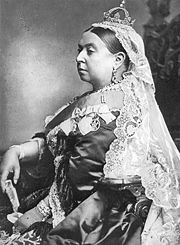
The final transition to a constitutional monarchy was made during the long reign of William IV's successor, Victoria. As a woman, Victoria could not rule Hanover, so the personal union of the United Kingdom and Hanover came to an end. The Victorian Era was an historic one for the United Kingdom, and was marked by great cultural change, technological progress, and the establishment of the United Kingdom as one of the world's foremost powers. In recognition of British rule over India, Victoria was declared Empress of India in 1876. However, the reign was also marked by increased support for the republican movement, due in part to Victoria's permanent mourning and lengthy period of seclusion following the death of her husband in 1861.
Victoria's son, Edward VII, became the first monarch of the House of Saxe-Coburg-Gotha in 1901. In 1917 the next monarch, George V, replaced "Saxe-Coburg-Gotha" with "Windsor" due to the anti-German sympathies aroused by the First World War. George V's reign was marked by the separation of Ireland into Northern Ireland, which remained a part of the United Kingdom, and the Irish Free State, an independent nation, in 1922.
Monarchy in Ireland
In the 12th century the only English pope, Adrian IV, gave a papal bull authorizing King Henry II of England to take possession of Ireland. This was because Celtic Christianity at the time was not closely following the practices of the Roman Catholic Church, and was thereby accused of heretical beliefs. So the pope wanted the English monarch to annex Ireland and bring the Irish church into line with the Catholic Church. The pope granted Ireland to the king of England as a feudal territory nominally under papal overlordship.
Around 1170 King Dermot MacMurrough of Leinster was deposed and his country taken by his arch-enemy King Rory O'Connor of Connaught. Dermot escaped to England and asked Henry for help. Henry refused but agreed to allow him to use a group of Anglo-Norman aristocrats and adventurers, led by Richard de Clare, the earl of Pembroke, to help him regain his throne. Dermot and his Anglo-Norman allies succeeded and he became King of Leinster again. As a reward Dermot let de Clare marry his daughter. Because of this when Dermot died in 1171 de Clare inherited his throne and became King of Leinster. This made Henry afraid that de Clare would make Ireland a rival Norman state or a place of refuge for Anglo-Saxons, so he took advantage of the papal bull giving him possession of Ireland and went to the island with his English armies and forced de Clare and the other Anglo-Norman aristocrats in Ireland and some of the Gaelic Irish chieftains to recognize him as their overlord. Henry was thus Lord of Ireland under nominal papal overlordship.
This remained the status of Ireland until 1541. By then King Henry VIII of England had broken with the Catholic Church and made England Protestant. This made the pope's granting of Ireland to the English monarch invalid, so he summoned a meeting of the Irish Parliament that year to change his title of sovereignty over the island. There his title was changed from Lord of Ireland to King of Ireland, thus making the island a kingdom in personal union with the kingdom of England.
Ireland continued to have this status until 1800, when the Act of Union merged the kingdom of Great Britain and the kingdom of Ireland into the United Kingdom of Great Britain and Ireland. Ireland continued to be an integral part of the United Kingdom until 1922, when what is now the Republic of Ireland won independence as the Irish Free State. Ireland was a separate kingdom with the same monarch as Great Britain in a personal union from its independence in 1922 until 1949, when the Free State became a republic and severed all ties with the monarchy, while Northern Ireland remained within the Union, thus creating the United Kingdom of Great Britain and Northern Ireland.
After the Empire
Between the Balfour Declaration of 1926 and the passage of the Statute of Westminster in 1931 the unitary British Crown that operated over the entire empire was replaced by separate Crowns for each Dominion. Thus, the institution of the monarchy ceased to be exclusively British, the particular British monarchy existing only within the Crown's British jurisdiction, the UK. Reflecting this, George VI was separately King of the United Kingdom, King of Australia, King of Canada, and so forth. This "division" was enhanced with the subsequent patriation of each Realm's constitution from the UK over the ensuing decades.
Formerly every member of the British Commonwealth was a Commonwealth Realm. However, when India became a republic in 1950, it was decided that it should be permitted to remain in the Commonwealth, even though it would no longer share a common monarch with the other Commonwealth Realms. It was nevertheless decided that the British monarch would be acknowledged as " Head of the Commonwealth" in all Commonwealth member states, whether realms or not. The position is purely ceremonial.
George V's death in 1936 was followed by the accession of Edward VIII, who caused a public scandal by announcing his desire to marry a divorced American woman, Wallis Simpson, even though the Church of England opposed the remarriage of divorcées. Accordingly, Edward announced his intention to abdicate; the Parliaments of the United Kingdom and of other Commonwealth realms granted his request. Edward VIII and any children by his new wife were excluded from the line of succession, and the Crown went to his brother, George VI. George served as a rallying figure for the British people during the Second World War, making morale-boosting visits to the troops as well as to munitions factories and to areas bombed by Nazi Germany. George VI was the last British monarch to hold the title "Emperor of India", a title relinquished when India became independent in 1947.
George VI's death in 1952 was followed by the accession of the present monarch, Elizabeth II. Like her recent predecessors, Elizabeth II continues to function as a constitutional monarch. During her reign, there has been some support for the republican movement, especially due to negative publicity associated with the Royal Family (for instance, following the death of Diana, Princess of Wales). Nevertheless, a large majority of the British public supports the continuation of the monarchy.
Residences
The Sovereign's primary official residence is Buckingham Palace in the City of Westminster. It is the site of most state banquets, investitures, royal christenings and other ceremonies. Visiting heads of state usually stay in Buckingham Palace. Another principal residence is Windsor Castle, the largest occupied castle in the world. It is used principally as a weekend retreat; the monarch also resides there during Royal Ascot, an annual race meeting that forms a major part of the social calendar. The Sovereign's principal official residence in Scotland is the Palace of Holyroodhouse, more commonly called Holyrood Palace, in Edinburgh. The monarch stays at Holyrood Palace for at least one week each year, and when visiting Scotland on state occasions.
There are other palaces not used as residences by the monarch. The Palace of Westminster was the Sovereign's primary residence until 1530; although it is still officially a royal palace, it is the home of both Houses of Parliament. Thereafter the Sovereign's principal London residence was the Palace of Whitehall, which was destroyed by fire in 1698, to be replaced by St James's Palace. Although replaced as the monarch's primary residence by Buckingham Palace in 1837, St James's is still used for various official functions. For example, foreign ambassadors are accredited to the Court of St James's, and the Palace is the site of the meeting of the Accession Council. It is not one of the Sovereign's official residences: it is used by other members of the Royal Family. Other residences used by the Royal Family include Clarence House, the home of the heir-apparent, The Prince of Wales, and Kensington Palace.
The aforementioned residences belong to the Crown; they are held in trust for future rulers, and cannot be sold by the monarch. The monarch also owns homes in a private capacity: Sandringham House in Norfolk, is typically used from Christmas to the end of January; during parts of August and September the monarch resides in Balmoral Castle in Aberdeenshire in Scotland.
Style
The present Sovereign's full style and title is "Elizabeth the Second, by the Grace of God, of the United Kingdom of Great Britain and Northern Ireland and of Her other Realms and Territories Queen, Head of the Commonwealth, Defender of the Faith". The title " Head of the Commonwealth" is held by the Queen personally, and is not vested in the British Crown. Pope Leo X first granted the title " Defender of the Faith" to King Henry VIII in 1521, rewarding him for his support of the Papacy during the early years of the Protestant Reformation, particularly for his book the Defence of the Seven Sacraments. Henry VIII later broke from the Roman Catholic Church and established the Church of England; Pope Paul III revoked the grant, but Parliament passed a law authorising its continued use.
The Sovereign is known as "His Majesty" or "Her Majesty": in certain formal circumstances, "Most Gracious Majesty" or "Most Excellent Majesty" is used. The form "Britannic Majesty" appears in international treaties and on passports to differentiate the British monarch from foreign rulers. Queens Consort (wives of Kings) and Queens Dowager (widows of Kings) are entitled to the style "Majesty", but husbands of female monarchs are not. Thus the husband of the present Queen, the Duke of Edinburgh, is styled "Royal Highness".
The monarch chooses his or her regnal name, not necessarily his or her first name — King George VI, King Edward VII and Queen Victoria did not use their first names.
The ordinal used for the monarch takes into account only monarchs since the Norman conquest of England. If only one monarch has used a particular name, no ordinal is used; for example, Queen Victoria is not known as "Victoria I". After the Union of England and Scotland in 1707, numbering was based on previous English monarchs, not Scottish ones. In 1953 Scottish nationalists challenged the right of the Queen to style herself "Elizabeth II", on the grounds that there had never before been an "Elizabeth I" in Scotland. In MacCormick v. Lord Advocate, the Scottish Court of Session ruled against the plaintiffs, finding that the Queen's title was a matter of her own choice and prerogative. Nevertheless, it was announced that future monarchs would use the higher of the English and Scottish ordinals. Retroactively applying this policy yields no change in numbering.
Traditionally, the signature of the monarch includes their regnal name but not ordinal, followed by the letter R, which stands for rex or regina (Latin for king and queen, respectively). The present monarch's signature is "Elizabeth R". From 1877 until 1948 reigning monarchs also added the letter I to their signatures, standing for imperator or imperatrix (emperor or empress in Latin), due to their status as Emperor or Empress of India. Queen Victoria, for example, signed her name, "Victoria RI" from 1877 on.
Arms of Dominion
The coat of arms used by the Sovereign, known as the Arms of Dominion, are "Quarterly, I and IV Gules three lions passant guardant in pale Or [for England]; II Or a lion rampant within a double tressure flory-counter-flory Gules [for Scotland]; III Azure a harp Or stringed Argent [for Ireland]". The supporters are the lion and the unicorn; the motto is " Dieu et mon droit" (French for "God and my Right", which had been the personal motto of Henry VIII and has been the Sovereign's motto since his reign). Ireland is represented somewhat controversially, as most of the island is the independent Republic of Ireland, not a part of the United Kingdom — only Northern Ireland, a sixth of the island, is part of the UK.
In Scotland the monarch uses an alternative form of the Arms of Dominion in which quarters I and IV represent Scotland, II England, and III Ireland. The motto is "Nemo me impune lacessit" (Latin for "No-one provokes me with impunity"); the supporters are the unicorn and lion.
The monarch's official flag in the United Kingdom is the Royal Standard, and depicts the Arms of Dominion. (The Royal Standard used in Scotland depicts the Scottish version of the arms.) This flag is flown only from buildings, vessels and vehicles in which the Sovereign is present; elsewhere, the Union Flag is flown. The Royal Standard is never flown at half-mast because there is always a sovereign: when one dies, his or her successor becomes the sovereign instantly.

